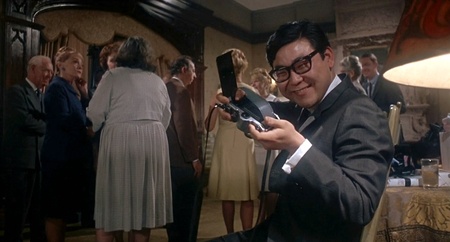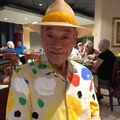SG: What was your impression of the role you were given in the film?
EH: I asked Roman about that. He said: “If you look around you see these Japanese businessmen all over the place and they all have cameras. They’re in groups of three and four and five, and they’re running all over the world—Europe, America—and they all have cameras. I wanted to put that in, so you’re it!”
SG: Your character is quite conspicuous in the final scene. It’s kind of an odd character to discover there in that scene of the story.
EH: Every character in that scene is kind of odd! It’s not a usual assemblage of folk.
SG: True! This selection of character actors and theater folk was really, I think, another example of Polanski’s genius—they all seem odd yet somehow familiar at the same time.
EH: Right. Individually you might look at them and think, “Oh, she’s a nice old lady,” but in that setting suddenly that nice old lady has another dimension. The film made what was normal extraordinary. A lot of those people, the older people, were extras, but he cast them extremely well. Even I was kind of creeped out whenever we were on the set.
SG: What was it like to meet and work with the cast and crew? Do you have any interesting memories of working with the actors?
EH: By the time they filmed that scene, Mia Farrow was getting divorced from Frank Sinatra, so she was experiencing an emotional trauma. Between takes she’d rush to her trailer, and she had a dressing trailer right in the middle of the sound stage, so we never saw her. But I became good friends with Sydney Blackmer and Ruth Gordon—we had a lot of lunches together. Sydney was trying to bring me in, telling me I have to get to New York. That’s of course primarily where he was, he was a great matinee idol on the Broadway stage. And Ruth hadn’t yet become the big star she later became; she was primarily known as a writer then. But she had just been to New York and seen Cabaret, so she was singing the songs and tried to teach them to me. We had a great time. Sometimes Patsy Kelly would join us, and that was pretty much it.
SG: That’s so great! I was born in 1970 so I recall seeing a lot of Ruth Gordon and Patsy Kelly while growing up.
EH: They’re delightful people. I love actors. I’ve spent my life with them!
SG: Was there any particular direction you were given for that final scene?
EH: No, it was just “say this” or “do this,” and it would change on different takes. I’ve worked with other directors who just say, “Do it the way you feel it; that’s why I hired you. You’re the actor.” And Roman was a little like that in that he primarily worked with the camera people. I don’t recall him giving much acting direction on the set. He may have said things to the actors privately, but not on the set. Everyone pretty much knew what they were going to do and he pretty much let us do what we wanted to do with it.
SG: Your character really does seem like he just stepped off the airplane; your Japanese accent is perfect.
EH: I had certainly heard enough of it! That was not a big stretch. I was good with a lot of accents though. Later I’d go on interviews and they’d say, “We need this part and we need it in a Japanese accent.” So I’d do it but this one producer said, “That’s not a Japanese accent.” Excuse me? I asked him what he thought a Japanese accent was. And he said, “Like Richard Loo in all the World War II films.” I said, “Well I hate to inform you, but I know Richard Loo, he’s from Maui, and his accent is basically a Chinese accent. His name is Loo, that’s Chinese. But then that was typical of the stereotypical treatment we got that I personally fought so hard against. Why can’t I speak the way I speak? I mean, you want the Queen’s English? I’ll give you that (mockingly as a perturbed producer): “Oh no! No!”
SG: In that final scene, when you were on set, did you look in the bassinet? Was there a baby or a doll prop in that bassinet? Because in the film we never see a baby.
EH: They later, I found out, tried to put a baby in the scene and they realized that it was not horrific. But no, there was no baby in the bassinet. Mia did a fabulous job!
SG: When the movie came out, do you recall any reactions from family or friends as to the story or the content of the film?
EH: Basically my people were actors and people involved in film in California, and they realized what a great horror film it was. My family was just happy to see me working (laughs)—they were not movie buffs or critics in any sense of the word.
But seriously, even when it was first released there was a sizable group who realized that it was a great, great film. The fact that there was no blood—it was Hitchcockian in that sense, horrifically suspenseful with no blood or anything, it just slowly built into this horrendous ending. It’s really a very unlikely story—the Devil’s child!—but Polanski made it happen.
SG: These days every horror film I see relies way too much on graphic effects and gore. Rosemary’s Baby is such a perfect film without any of that; the horror is all cerebral.
EH: The other film that’s always referenced, as far as horror films go, is The Exorcist. And Rosemary’s Baby doesn’t have all that slime all over the place or the head turning 360 degrees. As an artist I appreciate the artistry in Rosemary’s Baby; it got extraordinary effects out of so little. I can’t think of another horror film of that caliber.
SG: Do you have any opinions on the cultural impact of Rosemary’s Baby?
EH: I’ve done a number of films—I starred with Tom Hanks and John Candy in Volunteers (1985)—but when people ask me what films I was in, Rosemary’s Baby is the one I mention. Everybody instantly knows it, it’s a classic. Then when they ask me what part I played, I say, the baby of course! And they say, what!?
SG: Let’s talk about your appearances on Broadway. A few nights ago my wife and I watched Pacific Overtures on YouTube. You seemed as comfortable onstage as you did in front of the camera. Do you prefer one over the other?
EH: I have always loved the stage. Mainly because when you are performing onstage it’s just you and the audience, whereas with film it is always through the director’s eyes and the actor really has no control over anything. You come up with a performance but whether that performance even winds up in the final cut is another matter, much less what form it takes. I’ve actually used my film and television career to finance my stage work. The stage does not pay. I did a lot of stage in places like Milwaukee and La Jolla and I was losing money, going out of town to do those plays, but that’s where my heart was.
SG: You’re a true artist.
EH: Well, it’s what I loved, and I believe in pursuing what you love. I didn’t get rich or famous but I had a very fulfilling life as an artist. One time a writer-producer told me he was putting together a TV series, and that I and a certain well-known movie star would be perfect in it together. But I was on my way to Broadway to do Pacific Overtures—a chance of a lifetime. Until then, the last show to include Asians in the cast had been Flower Drum Song 20 years earlier, and after Pacific Overtures, another opportunity wouldn’t come along until Miss Saigon, 20 years later! Plus, how could I turn down Hal Prince and Stephen Sondheim? I could not call myself an actor and turn down Broadway for television. Maybe that was a dumb move, I don’t know. But I’ve never regretted doing Broadway; it’s one of the crowning achievements in my life, more so than anything I did in film.With movies, you can take somebody off the street and make him or her a star. With Broadway, it requires work. It’s discipline; it’s the art of acting and performing.
Twenty years later, we had to protest Miss Saigon because the lead role, an Asian character, went to Jonathan Price! It had been a big hit in London. Cameron Mackintosh was as big a producer as you could possibly get at that time; he was going to bring it to New York and it was going to be a smash hit. So we went through Actor’s Equity; they would all need to be permitted by Actor’s Equity to bring the London people over. Colleen Dewhurst was then president of Actor’s Equity and we explained our plight to her. The claim was that there were no Asian stars, according to Mackintosh. Our argument to Colleen and the Actor’s Equity board was, how can there be an Asian star when we are never even given the opportunity to play the Asian roles? It’s a self-fulfilling prophecy that there are no Asian stars if we are never given the opportunity to even audition! This happened in films too. The last leading Asian man was Sessue Hayakawa from way back in the 1930s!
Anyway, we stopped the show from opening for a while and that was important. Then our biggest advocate, Colleen, died. Now, 25 years later, there is some progress. They have just revived the show on Broadway and the lead character is being played by an Asian. It is gratifying, and I am very proud of what we have done to create this opportunity.
* This interview was conducted by telephone in early April 2017.
**This story was originally published on the horror genre blog, Devil In The Details on April 21, 2017. It has been edited and reprinted here with permission.
© 2017 Sonny Gardener





